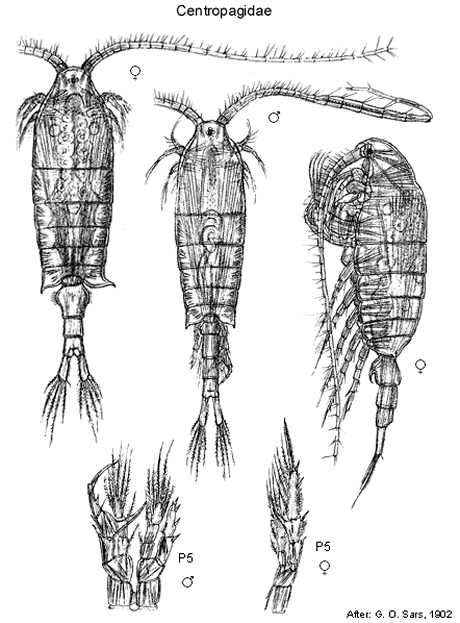 |
||||||
|
|
|
|
|
|
Calanoidea: FamiliesJ.M. Bradford-GrieveCentropagidae Giesbrecht, 1892 Description. Female. Rostrum with 2 filaments; rostral margin not extended. Cephalosome and pedigerous somite 1 separate; pedigerous somites 4 and 5 separate. Posterior corners of prosome in lateral view bluntly rounded, or with 1 acute point, or divided into 2 protrusions; dorsal view symmetrical, or asymmetrical. Urosome with 3 free somites, or with 4 free somites. Genital double-somite asymmetrical in dorsal view; gonopores close together and totally covered by single genital operculum; without seminal receptacles. Caudal rami symmetrical. Mouthparts. Antenna 1 with 24-25 free segments; ancestral segments X and XI partly fused. Antenna 2 exopod with 6-7 free segments; 10-11 setae; basis and endopod separate. Mandible basis with 4 setae; endopod terminal segment with 7-9 setae. Maxilla 1 basal exite seta present; exopod extends short of endopod distal border. Maxilla 2 coxal epipodite seta absent; endopod setae normal, or claw-like. Maxilliped coxal endite 2 with 3 setae. Legs. Leg 1 basis inner distal seta inserted directly on surface of joint; outer seta absent; endopod with 3 segments; exopod with 3 segments; exopod segment 1 with outer distal spine, or without outer distal spine; exopod segment 3 with 4 inner setae. Leg 2 endopod with 3 segments; exopod with 3 segments; exopod segment 3 with 2 outer spines, or with 3 outer spines. Leg 3 basis outer distal spine absent; endopod segment 3 with 5-8 setae. Legs 3 and 4 endopod with 3 segments; exopod with 3 segments; exopod segment 3 with 2 outer spines, or 3 outer spines; exopod segment 3 with 5 inner setae. Leg 4 endopod segment 3 with 4-7 setae. Legs 2-4 surfaces naked; terminal spine with outer border serrated. Leg 5 present; similar to legs 2-4; coxa inner border without seta; exopod segment 2 inner distal border extended into large spine completely fused to segment. Leg 5 exopod segment 3 outer border with 2 spines; inner border with 2 setae, or 4 setae. Mode of life. Pelagic, in oceanic waters or in coastal waters or in brackish waters or in freshwaters. Depth distribution. Epipelagic (0-500 m). Generic composition. This family contains 13 genera: Centropages Kroeyer, 1848 is marine; Gippslandia Bayly & Arnott, 1969; Gladioferens Henry, 1919; Isias Boeck, 1864; Parathalssius Dussart, 1986, Sinocalanus Burckhardt, 1913; Limnocalanus Sars, 1863 are brackish waters species; and Boeckella Guerne & Richard, 1889; Calamoecia Brady, 1906; Hemiboeckella Sars, 1912; Osphranticum Forbes, 1882; Parabroteas Mrazek, 1901; Popella Richard, 1888; Pseudoboeckella Mrazek, 1901 are freshwater species.
(Variant) Male (sexually dimorphic characters). Description. Male. Urosome symmetrical in dorsal view, or asymmetrical in dorsal view. Mouthparts. Mouthparts well-developed. Antenna 1 geniculate on right. Maxilliped endopod segments 5 and 6 with outer setae normal. Legs. Right leg 5 uniramous, or biramous; endopod 2-segmented, or 3-segmented; exopod 1-3-segmented, may be similar to other legs or may be highly modified into grasping organ. Left leg 5 uniramous, or biramous; endopod 2-segmented, or 3-segmented; exopod 2-3-segmented, may be similar to other legs or may be highly modified.
Cite this publication as: 'Bradford-Grieve, J.M. (2002 onwards). Calanoida: families. Version 1: 2 October 2002. https://crustacea.net'. |
|
|
|
|
|
|
|
|
|
Copyright © Australian Museum, 2002 - 2003
Australian Museum website
